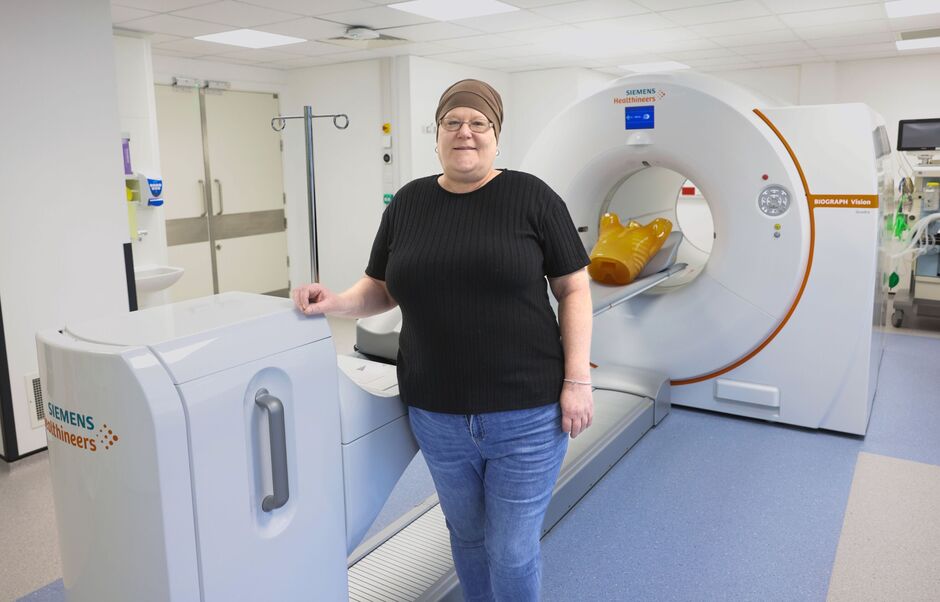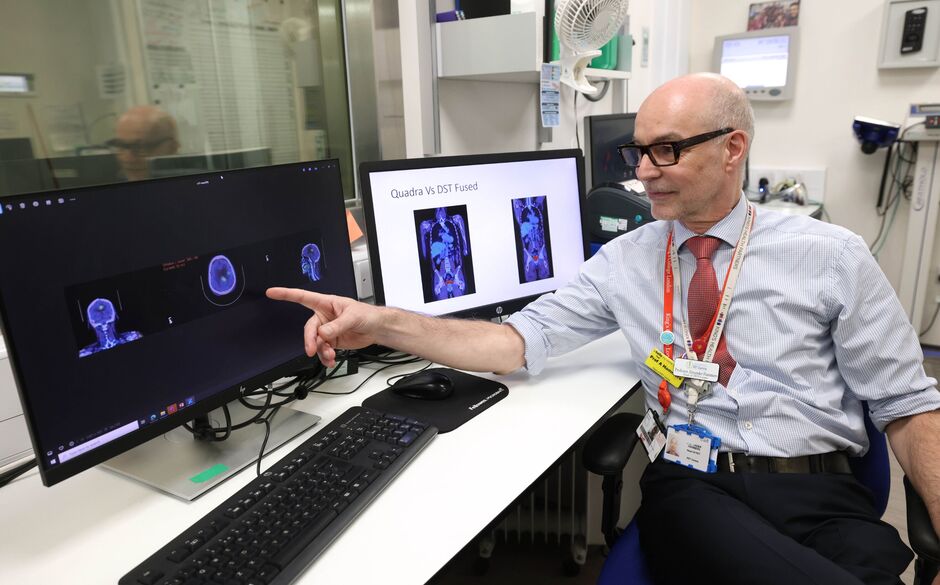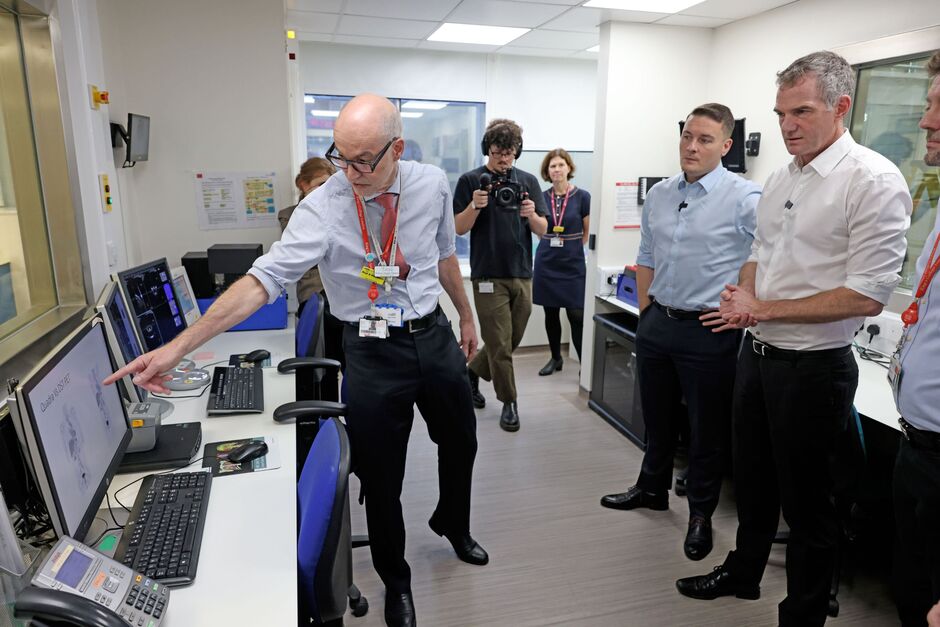Total-body PET scanner to transform diagnosis of serious illnesses
Science Secretary Peter Kyle hailed Britain’s potential as a science superpower as he unveiled a “transformative” new scanner set to speed up care for thousands of patients.
The total-body PET scanner installed at St Thomas’ Hospital in London is 40 times more sensitive than existing machines and slashes imaging time from 21 minutes to 10.
It is hoped the far more detailed images produced will allow cancer recurrence to be spotted earlier and give medics greater insights into a range of conditions affecting the brain and heart.
Mr Kyle told the Daily Express: “Cutting-edge scanners like these and the intelligence they provide can help UK patients live longer, healthier lives while easing the pressure on our NHS.
“Ultimately, these kinds of medical advancements will quite literally save lives – through earlier detection, faster diagnoses and more effective treatment in complex illnesses like cancer, dementia and heart disease.
Mr Kyle said the transformative tech would help patients live longer, healthier lives (Image: Jonathan Buckmaster)
“Ensuring our world-leading researchers have access to the most advanced technology is key to them unlocking the next medical breakthroughs, in turn improving the lives of people across the UK and beyond, while also growing our economy.”
The £10million total-body positron emission tomography (PET) scanner is one of three becoming operational in the UK. It works by detecting a radioactive substance injected into a patient’s arm. Medics can check how certain body functions are working by analysing where the radiotracer builds up in the body.
Cancer patient Sarah Corfield was the first to experience the new device at St Thomas’ Hospital. The 48-year-old has stage four melanoma and has undergone countless scans since her 2018 diagnosis.
She said: “The new scanner was a good experience – it felt very open, and not at all claustrophobic. It was much quicker – I was done in 15 minutes, and they told me the images were much higher quality.
“It was very smooth. I just lay there, like on a sun lounger, thinking of my little dog Maggie. It was very smooth, and much quieter.”
Neurologist Professor Alexander Hammers, head of the hospital’s PET centre, said the older machines could only scan 18cm of a patient’s body at a time “so when we wanted to scan somebody from eyes to thighs, we needed seven to nine bed positions”.

Sarah was the first patient to be scanned by the new machine (Image: Jonathan Buckmaster)
Now, higher quality images covering 1.6m of the body can be produced in half the time using half the amount of radiotracer.
Prof Hammers added: “It’s clearly amazing technology. We will be able to scan faster, we’ll be able to get better images and we’ll be able to drop the radiation dose for patient benefit.
“The images are so much clearer, they’re actually easier to read. It’s like the difference between seeing a normal scene and seeing the same scene in dense fog.”
The higher quality images could allow recurrence of prostate cancer, for example, to be spotted sooner when tumours are smaller.
The scanner will mainly be used for cancer patients but could also inform treatment of brain tumours, cardiac conditions, memory disorders and epilepsy.
Mr Kyle, who was joined on the visit by Health Secretary Wes Streeting, said: “Here in Britain, being at the cutting edge of this technology means that we can now find ways to roll this technology out, and that’s what we need to do to make sure that people in all parts of the country start to benefit form this sort of innovation.”
Mr Streeting added: “St Thomas’ Hospital’s new state-of-the-art scanner is an example of the government funded innovative technology we want all patients to have access to for their NHS care.

Prof Hammers explained how the new tech will speed up care (Image: Jonathan Buckmaster)
“Through our 10 Year Health Plan we will ensure that the NHS is made fit for the future, shifting the focus from analogue to digital, hospital to community and sickness to prevention, so that we can all receive care that is timely and effective.”
The scanner will also feed findings into a new National PET Imaging Platform, creating a bank of data from patients across the UK to aid researchers’ understanding of diseases.
The Government has invested a total of £32 million in the programme through UK Research and Innovation. Mr Kyle said “clever use of data” would enable experts to access anonymised information for research and help patients make more informed choices about their health.
He explained: “As a science superpower, we have the ability to harness the skills we have in the country, the infrastructure and particularly the welfare state.
“We have access to the whole country when it comes to involving people in improving our health, not just in the way we deliver healthcare but when we have development of new medicines or technologies, we can use the NHS to trial it and safely roll that technology out.

Health Secretary Wes Streeting also joined the tour at St Thomas’ Hospital (Image: Jonathan Buckmaster)
“It’s not just about the machines we have here. It’s also very, very clever use of data. We’ll only move forward when we can reassure people that these things are being done safely and with permission.
“But think of the potential that we have, that almost no other country in the world can. This means that British people, and British society, can benefit most.
“We are in the foothills of this in a new government but people shouldn’t underestimate the scale of our ambition going forward on behalf of every patient and every citizen of our country.”
Another machine will launch in Edinburgh in the coming months and a third installed at the Royal Free Hospital in London is not funded by UKRI but is part of the platform.
Ottoline Leyser, chief executive of UKRI, said: “A network of total-body PET scanners across the UK will radically improve the speed, comfort, and accuracy of scanning for patients, helping to reduce waiting times.
“Additionally, by involving patients in clinical research projects, and combining the data from across the UK, we will gain invaluable insight into many life-limiting illnesses, including cancer and Alzheimer’s disease and support the development of novel therapeutics.”
This post was originally published on here







